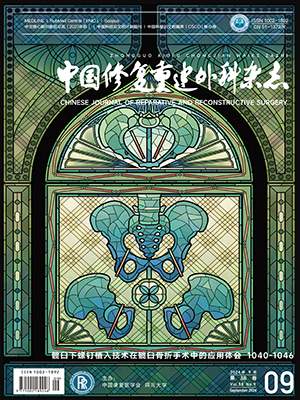Objective To compare the single femoral tunnel split-double-bundle posterior cruciate ligament (PCL) reconstruction with the singlebundle PCL reconstruction and to discuss the advantages of the modified reconstruction method. Methods Fourteen donated fresh-frozen human knee specimens were biomechanically tested, which included knee specimens from 12 males and 2 females, and their ages ranged from 20 to 31 years. The specimen length of the femur and the tibia was 20 cm. The tibial posterior translation and the PCL strains were first measured when PCL was in an intact state (the intact group, n=14). Then, PCL was cut (the cut group, n=14). The posterior translation was measured when a posterior load was applied. After that, the specimens were randomly divided into twogroups: the single-bundle group (n=7) and the double-bundle group (n=7). When the posterior load was applied to the tibia, the bundle strain and the tibial posterior translation were measured with the knees flexed at 0, 30, 60, 90 and 120°, respectively. Results While a 100 N posterior force was applied, the posterior tibial displacement of the intact PCL knee ranged from 1.97±0.29 mm to 2.60±0.23 mm at the different knee flexion angles. In the PCL-cutstate, the tibial displacement increased significantly from 11.27±1.06 mm to14.94±0.67 mm (P<0.05). After the singlebundle reconstruction, the posterior tibial translation ranged from 1.99±0.19 mm to 2.72±0.38 mm at the different knee flexion angles. In the split-double-bundle reconstruction, the posterior tibial translations ranged from 2.27±0.32 mm to 3.05±0.44 mm. The graft of the single-bundle reconstruction was tensioned from 0° to 120°, and the tibial displacement increased significantly at 90° compared with that at theother angles(P<0.05). In the doublebundle reconstruction, the anterolateral bundle and the posteromedial bundle were tensioned in a reciprocal fashion, and the tibial displacement had no significant difference at the five kinds of the flexion angles. ConclusionThe single femoral tunnel split-double-bundle PCL reconstruction canrestore the posterior tibial displacement at different flexion angles, and the tibial displacement in the single-bundle PCL reconstruction knee can be increased when the knee flexion is at 90°. In the double-bundle reconstruction, the graftcan be tensioned in a reciprocal fashion and the biomechanical features can be nearer to those of the normal PCL bundles.
Citation: TAO Cheng,WANG Wanchun,He Aiyong,et al.. AN EXPERIMENTAL STUDY OF SPLIT DOUBLE-BUNDLE POSTERIOR CRUCIATE LIGAMENT RECONSTRUCTION IN SINGLE FEMORAL TUNNE. Chinese Journal of Reparative and Reconstructive Surgery, 2007, 21(8): 820-824. doi: Copy




